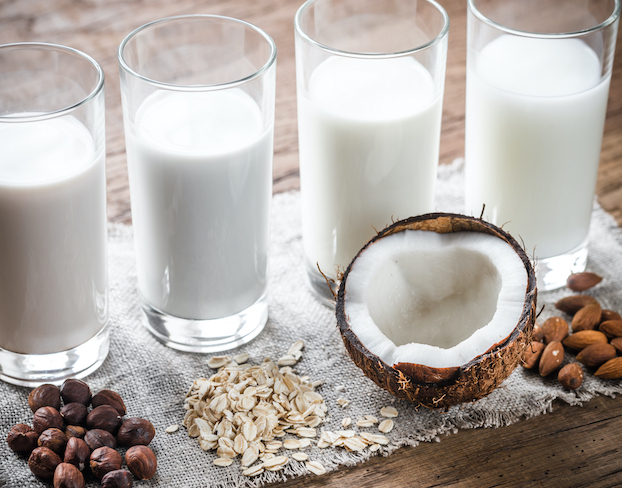Whether you’re drinking non-dairy milk for ethical reasons, health reasons, or to reduce your environmental footprint, you’re in luck: there’s a crazy number of choices on the market!
Of course, those choices can kind of be an issue, too. After all, when you’re at the grocery staring at all those different types of milk, how do you pick the right one for your recipe? Luckily, it’s not too hard if you know a little about them. Here’s what you should know about the most popular plant-based milks.
Almond Milk
The breakdown: Almond milk is high in vitamins and minerals, but its protein content is lower than that of dairy milk—just 1 gram of protein in most servings. It’s relatively creamy with a slightly sweet flavor.
How to use it: Almond milk can be a little too sweet for some savory dishes, but it’s great for desserts, especially when you want to add a nutty flavor. Try it in smoothies as well for vitamin-rich benefits with a slightly sweet kick.
Cashew Milk
The breakdown: Like almond milk, it has just 1 gram of protein for serving. However, cashew milk tends to be very creamy, with a more defined nuttiness.
How to use it: The creaminess of cashew milk makes perfect for most of your sweet and savory cooking. Since it’s thicker than other types of non-dairy milks, it goes great in coffee as well, and the nuttiness makes it a delicious choice for a bowl of cereal.
Soy Milk
The breakdown: Soy milk has a protein content comparable to cow’s milk (in addition to more antioxidants). It’s thicker and creamier than some other types of non-dairy milks, with a flavor that ranges from nutty to sweet.
How to use it: Soy milk is a great go-to option for most recipes that ask for cow’s milk, due to that high protein content. It’s stable at high temperatures, allowing you to cook with it easily, and its heaviness also makes it a good choice for sauce recipes.
Coconut Milk
The breakdown: Coconut milk—the kind that comes in non-dairy beverages, not in the can—has no protein at all, but it does have a high fat content, with a rich and creamy pour. The coconut flavor can be pretty strong, depending on the brand. The kind in the can, on the other hand, is very creamy and has a higher protein content.
How to use it: Coconut milk in both forms is better in recipes where you’re introducing strong flavors that will overpower the taste of the coconut (unless that’s what you’re going for). Canned coconut milk, specifically, is a great way to thicken up soups, sauces, and puddings.
Rice Milk
The breakdown: Thinner than other non-dairy milks, rice milk has a relatively subtle, sweet flavor and just 1 gram of protein.
How to use it: Rice milk’s delicate flavor makes it great for sweet recipes and baking, but it’s not ideal for recipes that call for thick or creamy non-dairy milks.
Oat Milk
The breakdown: With 5 grams of protein, this type of non-dairy milk can be compared to a fat-free cow’s milk. It’s not particularly thick or creamy, and it has a mildly sweet flavor.
How to use it: Oat milk can be used in most recipes, though it’s a good idea to keep the sweetness in mind. Try it in lighter soups or baking before you venture into other recipes. You can also add it to coffee or tea, as most brands won’t separate in the hot beverage.
No matter what you’re making, there’s a non-dairy milk for it! Knowing how all these options stack up against each other can help you find the right one for your recipe, but at the end of the day, it’s all about your preferences in terms of taste. Keep your favorites on hand to throw them into your favorite pantry staple recipes, and check out my other posts for more tips and recipes to use them in!




